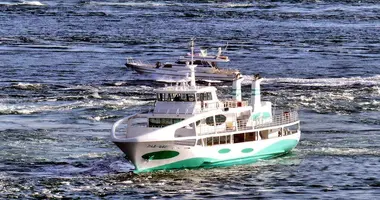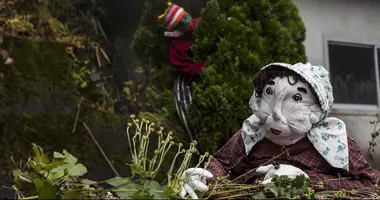Oboke Gorge
Oboke Gorge: read a guide to the Oboke Gorge area in Tokushima Prefecture, Shikoku, Japan. Oboke Gorge is an area of extreme beauty in Japan.
The Oboke Gorge and Takamatsu 大歩危
Stephen Gordon
The Oboke Gorge (sometimes known as Oboke-Koboke Gorge or Oboke-Iya Gorge) in Tokushima Prefecture is a deep ravine where the Yoshino River flows, surrounded by spectacular scenery.
It is not readily accessible by public transport, so we decided to take the Bonnet Bus tour. This turned out to be a great decision.

Oboke Gorge, Shikoku
Oboke Gorge Attractions
The Bonnet Bus is a 1950's-era bus that takes tourists for an approximately five-hour trip along the Oboke Gorge and back for a very reasonable fee. It leaves from the Awa-Ikeda Bus Terminal every day between 1 March and 30 November.
It can be booked by calling the Shikoku Transit Information Bureau on 0883 72 1231, but as speakers of very little Japanese we found it much easier to ask at the Takamatsu TIC.
Despite its location in another prefecture, they were happy to book for us. We took the train to from Takamatsu to Awa Ikeda. A direct Shimanto train takes just over an hour and allows you time to look around the small town of Awa Ikeda.
The Bonnet Bus was leaving at 11.30 am instead of 11.00 am on the day we went, so we took the Shiokaze train at 9.38 am, changed at Tadotsu to the Nanpu train and arrived at Awa Ikeda at 11.20 am, just in time to sprint down to the nearby bus terminal. The Bonnet Bus, with its six passengers, driver and guide was awaiting us. Stopping only to pick up another passenger at a large ryokan overlooking the town, we set off on our tour of the Oboke Gorge.

Carp Streamers (koinobori), Oboke Gorge, Shikoku
The gorge is a work of astonishing beauty, with a sometimes tranquil and sometimes rough river flowing between deep ravines leading down to small rapids. The river itself is dark green, and the forests on the surrounding hills and mountains are also green, with occasional wild cherry blossoms giving them a pink tinge.
The guide's commentary is in Japanese, but one thing that we understand are the frequent references to JR and 'onsen', hot springs.
On the other side of the gorge runs the JR Dosan line, in and out of tunnels, along the edge of the gorge, over bridges, sometimes surrounded by what look like rickety wooden structures but are undoubtedly feats of engineering allowing the railway to run along the side of the gorge.
Our first stop was for a boat trip (on one of the peaceful stretches of the river). We boarded open tatami-matted boats after a walk down numerous steps to the river bank and headed upstream to view vertiginous cliffs from the bottom, secluded landing spots and (once again) translucent dark green water.
On arriving back at the jetty we climbed the steps in the other direction to lunch. After the boat trip comes lunch of fish, rice, noodles, miso soup and tea in a large tatami mat room with several other tour groups.
One of our older fellow travellers enthusiastically bit the head off the fish (a local delicacy) but we noticed that some of the extremely young travellers were as unenthusiastic as we were about this procedure.
 Oboke Gorge, Shikoku
Oboke Gorge, Shikoku Ritsurin Koen, Takamatsu, Kagawa, Shikoku
Ritsurin Koen, Takamatsu, Kagawa, Shikoku
After lunch we travelled only a few hundred metres up the road to visit the tourist information centre and mineral museum Lapis Oboke (Tel: 0883 84 1489), an unexpectedly fascinating insight into the geological history of not only the island of Shikoku but also many other countries - probably including yours.
From there we moved on to the Heike Folk Museum (Tel: 0883 84 2029) with its exhibits of life in the old days, and then to the Kazurabashi Bridge. This bridge is constructed of vines in the old mountain style (although apparently now reinforced with steel cables) across which visitors carefully tread, trying not to look down. Our last stop was to view the Manikin Pis Boy, a statue of a little boy peeing over a very, very high drop at the side of the road. Then back to Awa Ikeda in time for us, and several of our fellow travellers, to get a train directly back to Takamatsu.
The Bonnet Bus is not the only way to go to the Oboke Gorge. Trains run also to Oboke JR Station, but there are a very few buses running along the gorge. There are also other attractions in the Oboke Gorge - white water rafting, hiking, and of course visiting onsens.
There are also other attractions in Takamatsu. Highly recommended are the Ritsurin-koen and Yashima Plateau and the open air house museum Shikoku-mura.
Ritsurin-koen is a park built in the 17th century as a garden surrounding the residence of the feudal lord of Kagawa, which was then known as Sanuki. It has lakes, gardens, groves, pine trees and, in season, cherry blossom.
Ritsurin-koen is most easily accessed by bus from the bus terminal outside Takamatsu JR Station, although both JR and the other local railway, Kotoden, have nearby stations.
Yashima Plateau was the scene of a major battle between the Heike and Genji clans in the 12th century. Today it is the location of major views of the Inland Sea, and best accessed by the Kotoden line, although the JR line that runs to Ritsurin-kōen also runs to Yashima. A shuttle bus runs from the Kotoden station to the top of the plateau.
After visiting the major cities of Tokyo or Osaka, Takamatsu and the Oboke Gorge are a delightful return to a small and beautiful world.
 Oboke Gorge Station, Shikoku
Oboke Gorge Station, Shikoku
Access - Getting to Oboke Gorge
Air
Takamatsu Airport has flights to Tokyo Haneda Airport (1 hour) and Fukuoka Airport (70 mins.)
Train
From Tokyo take the Shinkansen to Okayama (3 hours, 30 mins) and then change trains for Takamatsu (55 minutes).
Bus/Car
There are frequent highway buses to Takamatsu from Tokyo (approx 9 hours, 30 mins), Yokohama (9 hours) and Nagoya (8 hours). National Highway 32 is the major road passing through the Oboke region.
Nearby Attractions
The beautiful, remote, sparsely-populated Iya Valley can be visited in conjunction with Oboke Gorge.



















